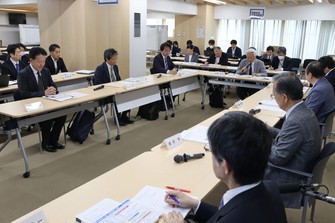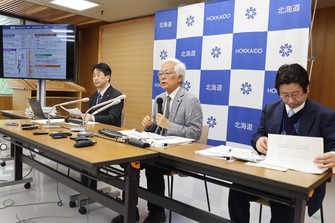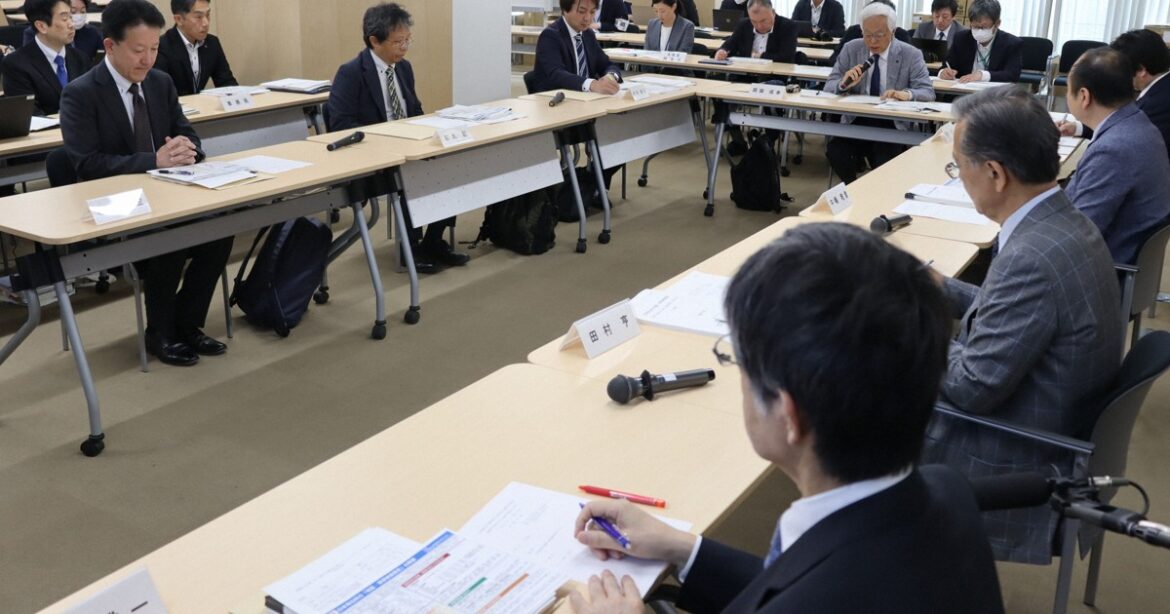
A working group of the prefectural disaster mitigation council which determined estimates of damage in an expected earthquake and tsunami sourced on the Sea of Japan coast of Hokkaido is seen at the prefectural government’s headquarters in Sapporo, June 3, 2025. (Mainichi/Hiroyuki Katano)
SAPPORO — Up to some 7,500 people in 33 municipalities along the Sea of Japan coast of Japan’s northernmost prefecture of Hokkaido could perish in the event of a magnitude 7 or greater earthquake, the prefectural government announced June 3.
The Hokkaido Prefectural Government is pressing local governments to strategize ways to minimize casualties, as the earthquake faults are close to land and evacuations would be tricky.
Hokkaido’s government in 2022 estimated that a major quake on the Pacific Ocean side of the prefecture would claim up to 149,000 lives, based on damage estimates for the area released the previous year by the national government. The latest projection was developed by a working group of the prefecture’s disaster mitigation team, which had been considering the issue since September 2023.
Fifteen faults on the Sea of Japan side were included in the data, divided into a total of 90 scenarios based on whether the quake would strike in the daytime, evening or late at night and during winter or summer — factors which greatly affect evacuations and other conditions. Basic Resident Register data from 2020 was used, and the tsunami height was based on figures given by the prefecture in 2017. Estimates of human casualties were based on two scenarios: 20% evacuating immediately and 70% doing so.
The results showed an estimated 7,500 deaths if the quake were to occur along a fault running from the region off the southwestern coast of Hokkaido to the area off western Aomori Prefecture on Japan’s main island, Honshu, late at night in winter, with most caused by the tsunami. In terms of material damage, the most destructive scenario would come from a quake occurring along a fault off the northwest coast of Hokkaido that extends inland in the evening or late at night in winter, when snow accumulates. It was estimated that about 16,000 buildings would be destroyed in such a scenario.
By municipality, the most deaths are expected in the city of Wakkanai in northern Hokkaido, with approx. 4,070 in the scenario of a quake along the fault off Hokkaido’s northwest during summer in the daytime. The village of Shimamaki was projected to see around 1,200 deaths during a Hokkaido southwest offshore fault quake occurring late at night in the winter — more than 80% of the total population. The town of Rebun, village of Kamoenai and town of Okushiri were also projected to see fatalities exceeding 50% of the total population.

Shigeyuki Okada, center, of Hokkaido University and others explain estimates of damage in the event of an earthquake and tsunami along the Sea of Japan coast of the northernmost prefecture of Hokkaido, at the prefectural government’s headquarters in Sapporo, May 27, 2025. (Mainichi/Hiroyuki Katano)
Shigeyuki Okada, a visiting professor in earthquake planning affiliated with the Center of Natural Hazards Research at Hokkaido University, who chaired the working group, said Hokkaido’s Sea of Japan coast has geographic characteristics that make quick evacuations difficult, with national highways extending along the coastline, settlements formed along national roads, steep cliffs approaching the coast and tsunamis that would reach the coast in a few minutes.
As the assumptions did not consider tsunami evacuation towers, detailed evacuation routes or other factors, earlier evacuation is said to be possible. Securing nearby high ground or other escape routes and creating evacuation plans for individual residents would improve outcomes.
Even so, Okada said that evacuating certain groups such as children and the elderly remains difficult and that the long-term measure of moving communities to higher ground is necessary.
While the national government’s data pins the probability of an earthquake on the Sea of Japan coast in the 0 to 0.1% range, Okada emphasized that people should prepare as if it could happen sometime.
The prefectural government will develop disaster mitigation plans based on these numbers. Damage estimates for the remaining Sea of Okhotsk coastline will also be readied.
(Japanese original by Hiroyuki Katano, Hokkaido News Department)


AloJapan.com